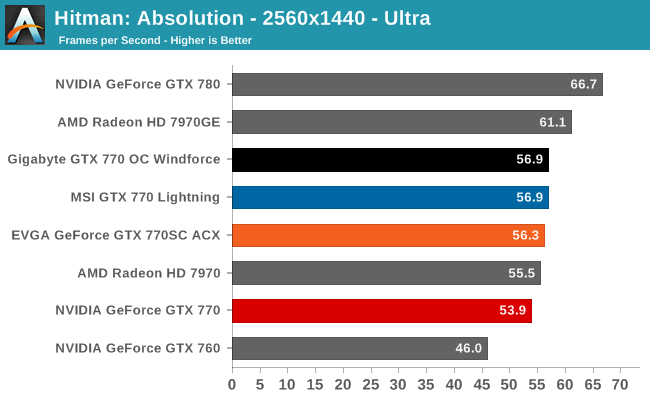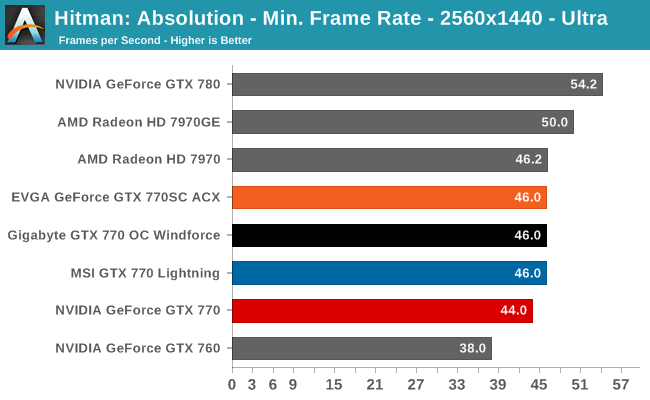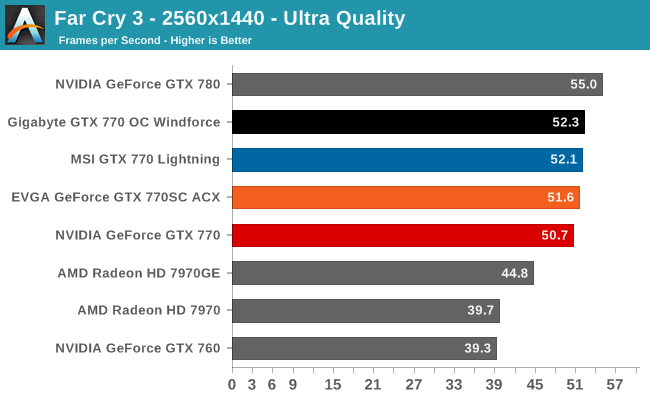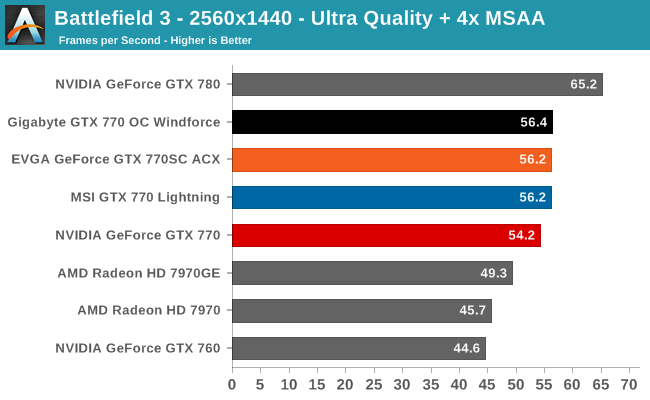The GeForce GTX 770 Roundup: EVGA, Gigabyte, and MSI Compared
by Ryan Smith on October 4, 2013 9:00 AM ESTShogun, Hitman, Far Cry 3, & Battlefield 3
Having taken a look at the specifications and construction of EVGA, Gigabyte, and MSI’s cards, let’s dive into the matter of their performance.
As a reminder the MSI GTX 770 Lightning has the highest factory overclock and the greatest power headroom (TDP 260W). However none of these cards has a memory overclock, and therefore performance gains will not always track the GPU overclock.

The fastest card here ends up being the MSI card, but not by much. The 4% gain over the stock GTX 770 is enough to be measurable and repeatable, however it doesn’t come close to MSI’s GPU overclock. Consequently at less than 1fps difference between the MSI, EVGA, and Gigabyte cards, it doesn’t really stand out. We’re likely facing a memory bandwidth limited scenario in our very first benchmark.


Hitman is much the same story as Shogun. The fastest cards are the MSI and Gigabyte cards, which tie for a 5% gain over a stock GTX 770, but they lack the performance gains to match their GPU overclocks. Furthermore with the EVGA card only behind by less than a frame per second despite it being the lowest of the factory overclocks, they’re really no better than tied. So once more we’re looking at some degree of a memory bandwidth bottleneck. Which just goes to show why it was so important that NVIDIA paired GK104 with 7GHz GDDR5 for this card, as extra memory bandwidth is clearly crucial.

Interestingly the Gigabyte card technically takes the lead here despite the fact that it has a slightly lower GPU clock than the MSI card, but at .2fps it’s little more than experimental variation. A 3% performance gain from the factory overclock once again points to a memory bandwidth bottleneck, which prevents these factory overclocks from shining.

Battlefield 3 is generally a repeat of Far Cry 3. Gigabyte once again has ever the slightest lead due to the variation in our test results, while no one is improving on the stock GTX 770 by more than 4%. In the case of the Gigabyte and EVGA cards this is essentially free performance, but it’s not much to talk about.










55 Comments
View All Comments
gandergray - Friday, October 4, 2013 - link
Ryan: Thank you for the quality review. From time to time, AT includes a table that shows relative performance and pricing of GPUs in AMD's and nVidia's GPU offerings. Would you include such table in this article?Ryan Smith - Friday, October 4, 2013 - link
Those tables are typically only used in what we consider "primary" reviews.For reviews and roundups of individual cards like this, we are less interested in how it compares to competitive cards, and more interested in how the reviewed products compare to other cards in the same product family. E.G. we've previously established how GTX 770 compares to 7970 and the like, but how do the individual 770 cards stack up?
BlakKW - Saturday, October 5, 2013 - link
Thanks for the review Ryan. I understand your reasoning for not including wider comparisons. For me, however, I always read GPU articles with an eye to "what does this mean for me?"...specifically, how is my 7950 boost holding up. I could wish for a better memory, I could open another tab and spend a few minutes pulling up past reviews...and I could wish that round-up and capsule reviews threw in a couple old charts (no reviewer comment or analysis needed), perhaps as an addendum titled "gpu overview" or "the big picture".Two games, one favoring AMD and one Nividia, would be great... or even a link to past charts for convenience. Anyway, great reviews...this isn't really a criticism, its just something I would like to see...
Ryan Smith - Saturday, October 5, 2013 - link
For something like that we have Bench. You can compare any cards we have in our results database, and it always contains the latest data we have collected.http://www.anandtech.com/bench/GPU13/
BlakKW - Saturday, October 5, 2013 - link
nice...never noticed that feature beforeGBHans - Sunday, November 3, 2013 - link
Ryan, how did you increase the max boost voltage from 1.2 to 1.212v? (Which app). I use afterburner but even though I move the voltage adjuster to 1.212, it reports at 1.2v.Btw, I picked up the 4gb version of the evga 770 (FTW) based on this review & the memory over clocks you saw, and it too is reaching 8+ghz on the memory.
And, yes, your Bench comparison tool is great and quite helpful.
neaoon - Monday, October 7, 2013 - link
hyyyyyneaoon - Monday, October 7, 2013 - link
I just want to add my story. I get paid over $87 per hour working online with Google! I work two shifts 2 hours in the day and 2 in the evening. And whats awesome is Im working from home so I get more time with my kids. Its by-far the best job I’ve had. I follow this great link >>>> uttr.it/ukvczrqFlunk - Friday, October 4, 2013 - link
Your comments about software from MSI, Evga and Gigabyte are a little strange as there is nothing at all stopping you from using any of their overclocking software on any of the cards mentioned. I use MSI Afterburner on my other branded cards all the time, it even works on laptops.jordanclock - Friday, October 4, 2013 - link
The point is that this software is part of what you're paying for when you purchase these cards. It's part of the value of the whole package. You could easily swap the heatsinks and fans, but those are still valid points to raise when reviewing the product as a whole.